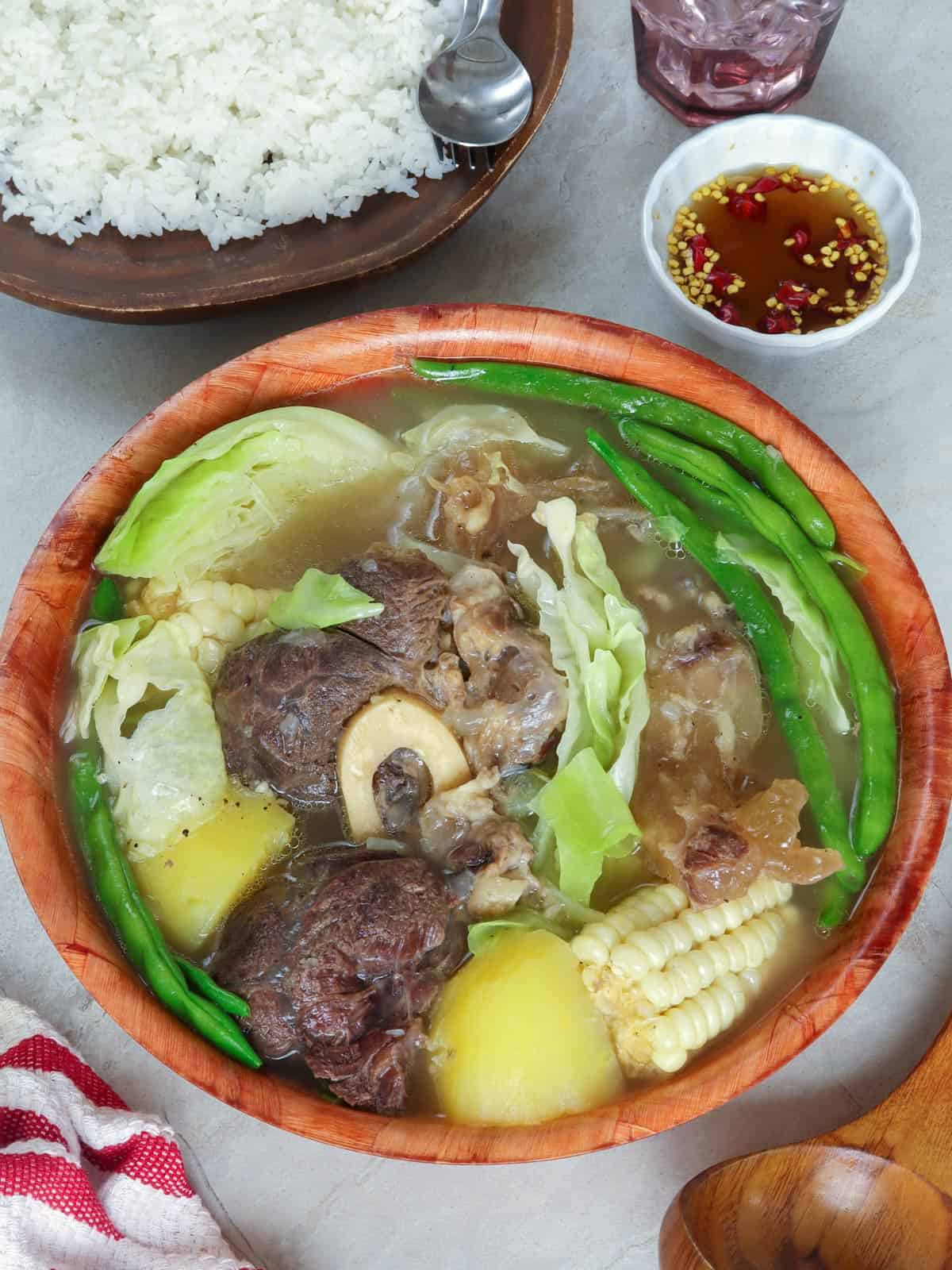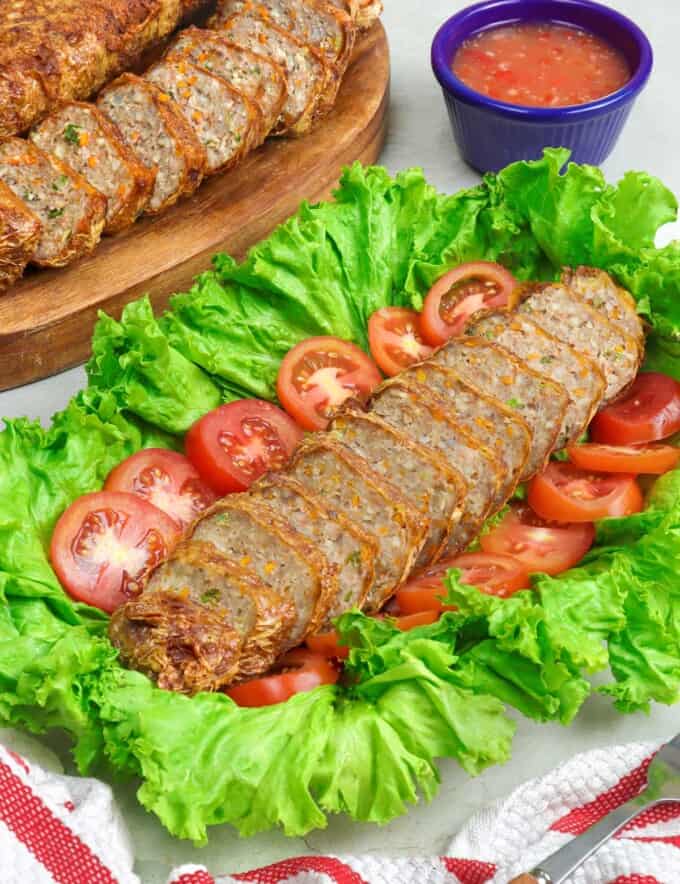Nilagang Baka is the ultimate comfort food! This Filipino-style boiled soup with fork-tender beef shanks, tendon, and vegetables is hearty and tasty.

It's been raining hard since late this afternoon here in our neck of the woods, so I thought I'll update the photos and repost this nilagang baka recipe. Because what better way to warm our bellies on a cold, rainy day than a piping-hot bowl of beef soup?
What is Nilaga
Nilaga, which means "pinakuluan" or "boiled," refers to Filipino meat and vegetable soup where chunks of beef, pork, or chicken are cooked in seasoned broth until fork-tender. Quartered onions, peppercorns, and fish sauce add flavor to the soup while abundant local produce such as potatoes, corn, cabbage, pechay, green (Baguio) beans, and carrots turn it into a hearty one-pot meal.
Adapted from the Spanish cocido, this boiled soup has taken root in the Filipino food culture as the epitome of comfort food. It's commonly prepared and enjoyed on rainy days to ward off the cold or on special Sunday meals when the whole family gathers in the ancestral home.

Beef cut to use
Use meat high in connective tissues such as beef shank and tendon for a gelatinous and full-bodied broth. Tough, sinewy, or bony cuts such as brisket, chuck, ribs, or neck bones are also great options in making a tasty nilaga.
These cheaper and tougher cuts of meat break down in the low and slow cooking process and become tender while infusing the soup with flavor.

As with any good soup, the broth is the heart of this beef nilaga. To ensure it's clean and bright, tend to it closely, especially during the first initial minutes it is brought to a boil, and religiously skim the scum that floats on top. Once free of froth, lower the heat and ensure it doesn't rise to more than a simmer.
For a sediment-free soup, you can also blanch the meat and bones to help remove blood, coagulated protein, and any impurities that may cloud the stock. It's an optional step, but it does make for a clearer broth.
How to blanch meat
- Place beef in a pot with enough cold water to cover. Bring to a boil over medium heat, skimming scum that floats on top.
- Drain the meat, discard the liquid, and rinse the meat and pot well.
- Return the rinsed meat to the pot, cover it with cold water for the second time, and cook the soup as directed in the recipe below.
Quick tip
Since beef tendons are tough and fibrous connective tissues, they are almost impossible to cut uncooked. Ask butcher to slice tendons into pieces or halfway during cooking and when tendons are soft enough to slice through, remove from pot, cut into serving parts and then return to pot to continue to cook.

How to serve
Although the beef soup is a complete meal and can be enjoyed on its own, it's traditionally served with steamed rice on the side along with patis (fish sauce) to dip in the succulent meat and tender-crisp vegetables. It's also customary to provide an extra helping of the hot broth in a separate mug or bowl to slurp while partaking in the meal.
Storage instructions
- Store leftovers in an airtight container and refrigerate for 3 days or in the freezer for up to 2 months.
- To reheat, place in a pot and warm over medium heat to 165 F. Or heat in the microwave at 2 to 3-minute intervals, stirring after each interval.
If you want more ways to cook nilaga, check out this pork version with kalabasa and pechay. Enjoy and stay warm!
More soup recipes
Ingredients
- 2 pounds beef shanks, bone-in
- 1 pound beef tendons
- 8 cups water
- 1 large onion, peeled and quartered
- 1 teaspoon peppercorns
- 2 tablespoons fish sauce
- 3 corn, husked and cut into halves
- 2 medium potatoes, peeled and quartered
- 1 small cabbage, cut into wedges
- 12 green beans, ends trimmed
- salt to taste
- green onions, optional
Instructions
- In a pot, combine beef shanks, beef tendon, and water. Over medium heat, bring to a boil, skimming scum that floats on top.
- When clear of froth, add onions, peppercorns, and fish sauce.
- Lower heat, cover and cook at no more than a simmer for about 2 to 2 ½ hours or until shanks are tender and tendons are soft. Add more water as needed during cooking to maintain about 6 to 7 cups.
- Add corn and cook for about 5 to 7 minutes.
- Add potatoes and cook for about 5 minutes or until almost tender.
- Add green beans and cabbage and cook for another 2 to 4 minutes or until vegetables are tender yet crisp.
- Season with salt to taste. Ladle into serving bowls and garnish with chopped green onions, if desired. Serve hot.
Notes
Video

Nutrition Information
“This website provides approximate nutrition information for convenience and as a courtesy only. Nutrition data is gathered primarily from the USDA Food Composition Database, whenever available, or otherwise other online calculators.”








Missy Fuchs Burgess says
Thank you so much! I’ve read through your recipes and it’s the closest to my moms cooking(We’re from Iloilo)… although my mom has different variations, I like trying different recipes. Your website and my mom makes an awesome duo!!!
Lalaine Manalo says
I can't compete with mom but I'm glad my recipes have been helpful 🙂
Efren Martinez says
Simple and easy to follow instructions.
Am a novice husband cook.
Lalaine Manalo says
Thank you for the 5-stars. Glad the recipes are helpful.
Jenny says
I usually seek out recipes from Kawaling Pinoy! Main dishes to desserts I haven’t found one yet that I didn’t love! I found you on Pinterest and will keep following! ❤️
Lalaine Manalo says
Thank you so much! You made me so happy!
Len says
I used to copy the recipes from other sites but when I got crossed of yours , it's the only one now I go to for some recipes. I like your way of cooking, the ingredients you use and your instructions are clear and easy to follow. You also offer alternative for the ingredients but most of all you cook the Kapampangan way , which the best cooks do. It is a popular notion that the Kapampangan are the Pilipino cooks.
And I like also your starting by telling the background of the recipe. That is so informative. I express my ah's! And oh's when I read a part that I did not know before.
Please continue doing that. That makes you a cut above the rest.
Len says
Corrections on my comments:
got across *
Kapampangan are the best Pilipino cooks*
Lalaine Manalo says
Thank you so much for your kind words. You made my day 🙂
michelle says
hello po, can i substitute plantain instead of saba? thank you.. 🙏🏼
Lalaine Manalo says
Wala po etong saging saba, patatas at corn po ang gamit. But yes, for recipes na may saba, plantain is a good substitute.
Julianna says
How do you add Saba to this dish? I would like to try but I’ve never cooked with it before
Lalaine Manalo says
You can add briefly pan fry them and then add them to the soup during the last 3 to 5 minutes of cooking time.
Da says
Hello po! Okay lang po ba kung i-substitute ko ang chuck eye steak for this? Dapat po kasi steak gagawin ko eh kaso naisipan ko na gusto ko na lang po ng may sabaw at nilaga agad pumasok sa isipan ko. Hehe
Lalaine says
You can use it if that's all you have although I don't use it for soups/stews because it's too lean and dry.
Clark says
Hello, is it ok to substitute the beef tendon to beef tenderloin?
Lalaine says
Hello Clark
Unfortunately, beef tendon and tenderloin are very different parts. While tenderloin is the tender meat part, the tendon is a very tough, fibrous collagen that takes hours to cook. If you don't have access to it, just omit. It's not really a standard ingredient in nilaga, I just like to add it because it adds a depth of flavor and I like its texture when it's cooked until very tender.
Michelle says
Salamat po sa mga recipe!
Lalaine says
You're welcome, Michelle. Salamat rin sa pagsupport nang Kawaling Pinoy 🙂
Ray says
To date I still do my nilaga the way you cook yours! Thank you again for sharing 😀
Lalaine says
Thank you, Ray 🙂
Ben says
I was just treated to nilaga for the first time by some filipino friends I made at work. Simple and delicious, I want to return the favor for them sometime and this seems perfect. Now if I can only learn tagalog. Salamat!
Mark says
I'm going to try this for the first time..
Bards says
Your recipes are amazing. I follow the proportions and the cooking time you give and everything ALWAYS turn out perfect! Thanks! Happy cooking!
Mary Jo says
Hi Lalaine, firstly, I'd like to let you know that your food blog is so much enjoyable to read. Thank you for sharing..
One question about this recipe, is it the same method and ingredients with bulalo?
Lalaine says
Hello Mary Jo
Yes, bulalo and nilagang baka share the same method of cooking but bulalo uses bone-in beef shanks, pechay and corn. Both are delicious 🙂
Hllda payad says
Ang sarap sarap po ng mga niluluto ninyo.sabi nga nila basta kapampangan masarap magluto.thank you po for sharing.
Lalaine says
Salamat, Hilda 🙂
Dinner at Six Thirty says
aaaaahhhh...the flavors of home! <3
Lalaine says
Yep, this is classic comfort food rom home 🙂